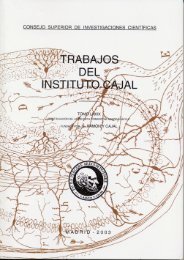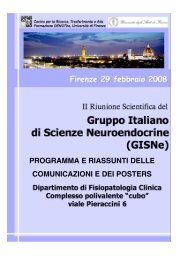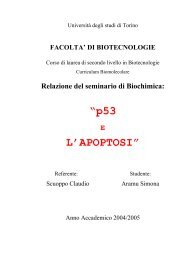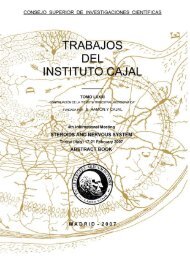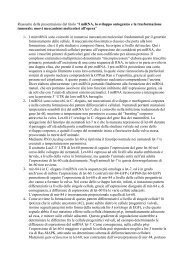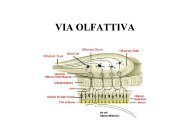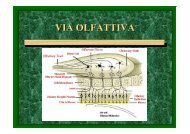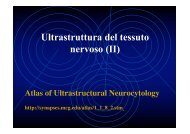GISNe - Anatomia, Farmacologia e Medicina Legale
GISNe - Anatomia, Farmacologia e Medicina Legale
GISNe - Anatomia, Farmacologia e Medicina Legale
Create successful ePaper yourself
Turn your PDF publications into a flip-book with our unique Google optimized e-Paper software.
INDIVIDUAL DIFFERENCES IN CARDIAC AUTONOMIC AND SYMPATHETIC-<br />
ADRENOMEDULLARY RESPONSES TO SOCIAL CHALLENGE<br />
Andrea Sgoifo, Francesca Mastorci, M. Angeles Pico’ Alfonso<br />
Stress Physiology Lab, Department of Evolutionary and Functional Biology, University of<br />
Parma, Parco Area delle Scienze 11/A, 43100 Parma, Italy<br />
Social stressors play a significant role in the onset and progression of cardiovascular diseases<br />
such as hypertension, atherosclerosis and cardiac arrhythmias. Human and animal data suggest<br />
that an important determinant of cardiocirculatory stress reactivity and morbidity is the<br />
individual behavioral strategy of coping with environmental challenge. This paper summarizes<br />
the results of a number of studies that we performed in rodents and humans, aimed at shedding<br />
further light on the relationship between individual aggression levels and associated<br />
dominance/subordination status and short- and long-term neuroendocrine and cardiovascular<br />
stress reactivity. Our data suggest that: (i) individuals belonging to the 'aggressive tail' of a<br />
wild-type rat population are characterized by a higher sympathetic-adrenomedullary activation<br />
during both social and non-social stress episodes; (ii) in rats, cardiovascular habituation takes<br />
place when social challenge is an intermittent victory experience, whereas no habituation is<br />
observed across repeated defeat episodes; (iii) when social dominance is challenged, rats<br />
exhibit long-term alterations of heart rate circadian rhythmicity, such changes being<br />
modulated by the individual level of aggression; (iv) in mice, chronic subordination induces<br />
transient alterations of heart rate circadian rhythmicity and permanent myocardial damage, the<br />
latter consisting of scattered foci of fibrosis; (v) in humans, subjects with higher scores of<br />
submissive behavior are prone to larger cardiac accelerations and parasympathetic suppression<br />
during and after a laboratory stressor. Altogether, these data underline how important it is to<br />
carefully consider individual differences in trait and state aggression, as well as the context in<br />
which aggression is expressed, when studying acute and long-term autonomic and<br />
neuroendocrine effects of social interactions.





